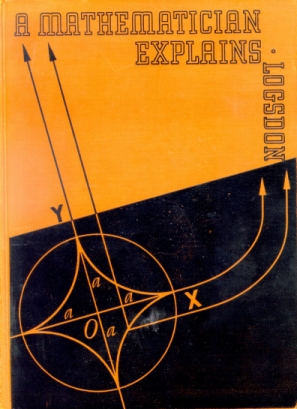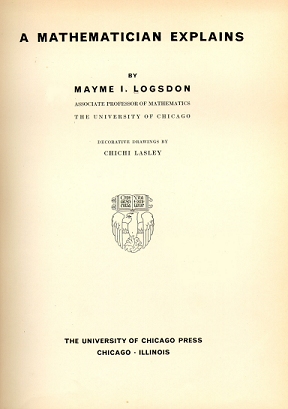Mayme I. Logsdon
A Mathematician Explains
The University of Chicago Press, Chicago, Illinois, 1935


Preface
The idea that each individual has something to gain by acquiring a knowledge of mathematics is not new. according to Plato, "the art of calculation (logistika) and arithmetic are both concerned with number; those who have a natural gift for calculating have, generally speaking, a talent for learning of all kinds, and even those who are slow are, by practice in it, made smarter. But the art of calculation is only preparatory to the true science; those who are to govern the city are to get a grasp of logistika, not in the popular sense with a view to use in trade, but only for the purpose of knowledge, until they are able to contemplate the nature of number in itself by thought alone."
The college curriculum of the University of Chicago, adopted in 1930, includes a course of three lectures per week for one year in the physical sciences, paralleled with small-group discussions. The conduct and content of this course, which is required of all college students, are motivated by the acknowledge that many persons pass through youth, adulthood, and old age with no understanding of, or interest in, the operation of natural laws.
This course, planned for the student who has no native interest in the physical sciences, is perforce entirely different from a course which might be designed for a student who has a definite interest in this field. Its aim is to provide explanations for what is happening about us and to show with some detail how the human race through the ages has arrived at the explanations here presented. In this development mathematics plays a twofold role, viz., the unfolding and attaining of pure mathematical theory and the invention of mathematical processes as aids to astronomy, physics, geology, and chemistry. In ancient times the latter was the predominating function of the science called "exact"; in modern times the former aspect of mathematics has become of ever increasing importance.
The attempt to give in a a few lectures a vivid picture of the historical development of the mathematics of classical times with a description of the types of problems which led to the growth of elementary concepts of arithmetic, algebra, geometry, and trigonometry, and to give something of the purport and processes of the modern subjects, analytical geometry and the calculus, to the end that the student may obtain fairly definite ideas of their meanings and uses in modern life and of their relations to the various fields of the physical sciences, has been rendered more difficult than pleasant by the lack of satisfactory references for extensive reading;and it is to meet that need that this book has been written. In it the subjects which may be considered important for the general education of a person who is not a specialist in a physical science have a more complete treatment than can be given in a few lectures, but at the same time the text does not go so far afield as to confuse with new ideas or with technical notions. It does not take the place of any one or more texts in the standard courses in college mathematics, but its sponsors believe that it will prove to be of use along the following lines:
- To provide the mathematics for general physical science courses, as at the University of Chicago.
- To serve as a text for a one-hour or a two-hour orientation course in college, junior college, or senior high school.
- To serve as a reading reference for first-year and second-year mathematical courses in college or junior college.
- To serve as a supplementary text for courses in the teaching of mathematics in normal schools and teachers colleges.
- To serve as an eye-opener for the adult who knows no mathematics beyond elementary algebra and geometry but who has a healthy curiosity concerning the science whose development has made possible this age of the machine.
The University of Chicago, October 3, 1935
Table of Contents
1. Nature of Mathematics
2. Arithmetic
3. Algebra
4. Geometry and Trigonometry
5. Analytic Geometry
6. The Differential Calculus
7. The Integral Calculus
8. Mathematical Interpretations of Geometrical and Physical Phenomena
9. Mathematics and Life
